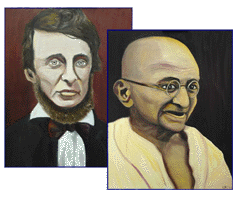"The whole aim of practical politics is to keep the populace alarmed (and hence clamorous to be led to safety) by menacing it with an endless series of hobgoblins, all of them imaginary." ~ H.L. Mencken
Native American History Government Schools Don't Want You to Know
Exclusive to STR
December 4, 2006
In a recent column (Teaching American History), Gary North provides an alternative perspective that is not presented in textbooks used by students in tax-funded schools. In an example of how these books distort history, he cites lack of coverage given to the colonial period when civil government was weak and decentralized. It would not do for government schools to emphasize a time when cultural, social and economic development occurred without government intervention.
North specifies several topics that he would expand on regarding colonial history. Among these are relations between Indians and Europeans. Statist books have focused mainly on political and military conflict culminating with government's role in ethnic cleansing. A nonstatist approach would involve studying interpersonal relationships and mutually beneficial trade.
From my own study of history, I have been impressed by developments which occurred among several Indian tribes before the arrival of Europeans and the establishment of a coercive state authority. The Haudenosaunee, more commonly known as the Iroquois Confederacy, is the best example of a pre-colonial society based on mutual respect and cooperation among its members. Based on the Great Law of Peace, the Haudenosaunee is estimated by modern historians to date from approximately the 12th Century. It consists of six tribes (Mohawk, Oneida, Seneca, Onondaga, Tuscarora and Cayuga) inhabiting most of upstate New York and parts of lower Ontario in Canada.
The Great Law of the Haudenosaunee is based on the teachings of the Great Peacemaker, who traveled among various tribes promoting a philosophy based on inner peace, spiritual power, and ethical behavior. Peace is not the absence of war, but rather an inner strength an individual has when he is at peace with himself and his neighbors. Power is a spiritual force that unites individuals in a common cause. Ethical behavior, or righteousness, is based on shared moral values and a common perception of justice. This is reinforced by custom, manners, beliefs and traditional rituals.
The primary social and economic unit of Haudenosaunee culture is the clan, which is headed by the oldest female member, known as the clan mother. Membership in the clan is determined by a common female ancestor. The clan mother appoints a male chief to represent the clan at a tribal council, where disputes between clans are resolved.
Relations between the Haudenosaunee and other countries, including the United States, are governed by treaties dating back as far as 1692. The Haudenosaunee represent themselves as a sovereign nation, and have never acquiesced in American or Canadian authority over their territory as defined by those treaties. They maintain their own laws in accordance with the principles espoused by the Great Law of Peace, and refuse to accept federal grants or subsidies.
The Haudenosaunee claim to be the oldest continuing participatory democracy. Their ideas may have influenced colonial leaders such as Ben Franklin, Thomas Jefferson and Thomas Paine. There is some evidence that their moral values concerning life and behavior had a significant impact on American culture, especially in the northeastern states, well into the 19th Century. For example, Henry David Thoreau spent a great deal of time with, and writing about, native Americans. Their emphasis on spiritual development and ecological harmony impressed him greatly, and probably contributed to his transcendentalist ideas.
The Haudenosaunee developed a culture based on mutual respect and cooperation between various tribes long before the arrival of European settlers. They survived encroachments on their territory and sovereignty by adapting to modern technology and lifestyles while maintaining their spiritual values. As a result, they have not become dependent on federal subsidies and support like so many other native tribes.
As Gary North pointed out, high school history textbooks tend to focus on government and politics to reinforce student's perception of the importance of the state in their lives. However, there may be some glimmer of hope this may be about to change. From my own experience as a graduate student, there is more emphasis on social and cultural history, including the colonial period, than there was a few decades ago. More women and minorities are writing books and teaching classes about the multicultural heritage of America. I recently came across a high school textbook that discussed the Haudenosaunee and highlighted several portions of the Great Law of Peace. I think the real issue at this point is whether generations of students inculcated with allegiance to the nation and its leaders will be receptive to alternative interpretations.







 Reprint Rights
Reprint Rights